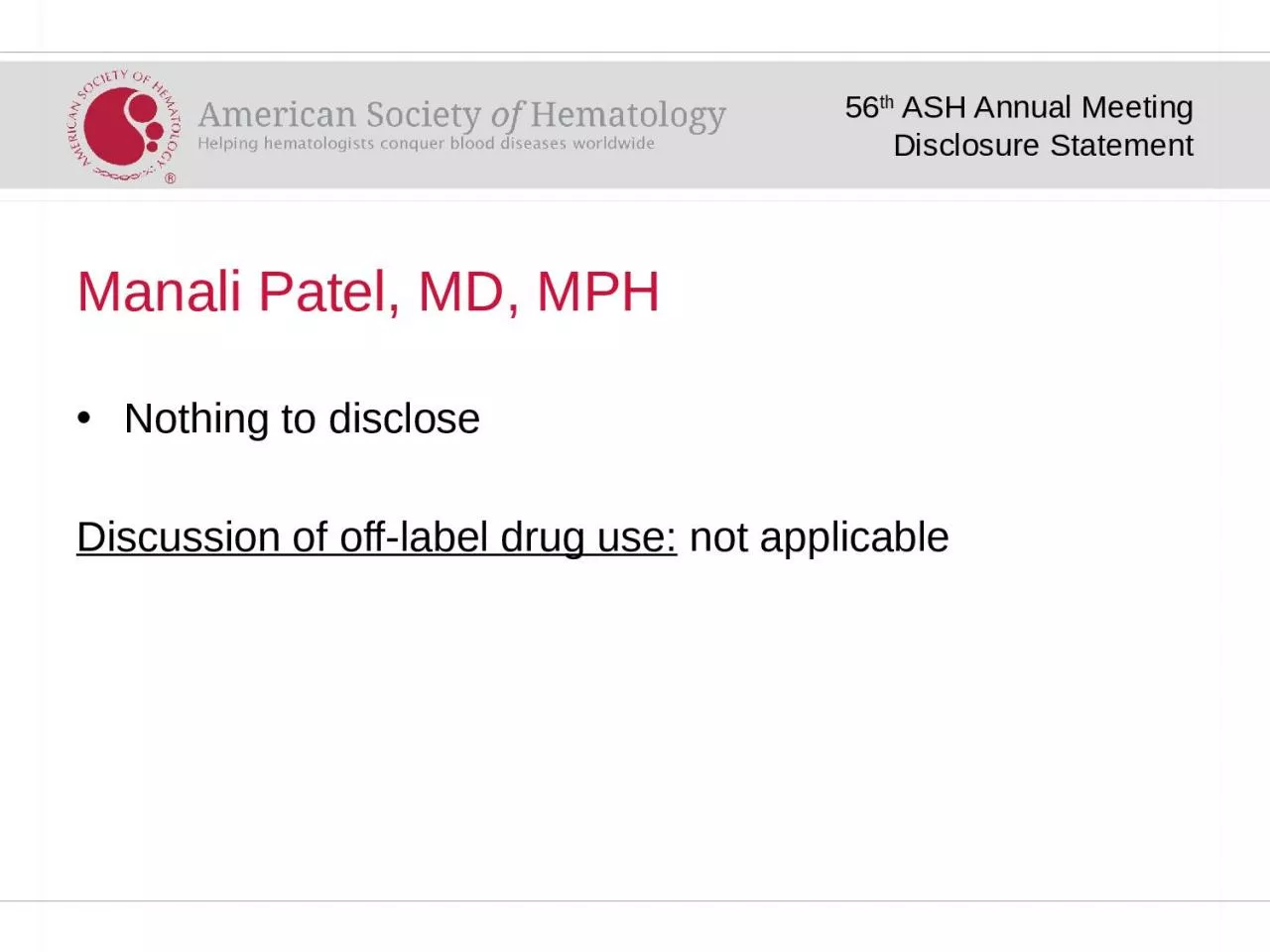

Discussion of offlabel drug use not applicable 56 th ASH Annual Meeting Disclosure Statement Overview Background Achieving the Triple Aim in Cancer Fellow A3 Thinking Questions Workshop ID: 1040916
Download Presentation The PPT/PDF document "Manali Patel, MD, MPH Nothing to disclos..." is the property of its rightful owner. Permission is granted to download and print the materials on this web site for personal, non-commercial use only, and to display it on your personal computer provided you do not modify the materials and that you retain all copyright notices contained in the materials. By downloading content from our website, you accept the terms of this agreement.
1. Manali Patel, MD, MPHNothing to discloseDiscussion of off-label drug use: not applicable56th ASH Annual MeetingDisclosure Statement
2. OverviewBackgroundAchieving the Triple Aim in Cancer Fellow A3 ThinkingQuestionsWorkshopMock A3 Thinking Projects
3. Achieving the Triple Aim In Cancer Manali I. Patel, MD MSPHInstructor, Division of OncologyClinical Excellence Research CenterStanford University School of MedicineHealth Services Research, Palo Alto Veterans Administration
4. Overview Care delivery“Triple Aim”Value Improvement OptionsClinical Excellence Research Center Innovations in care delivery User-centered design methodologiesAchieving the “Triple Aim” in Cancer CarePilot test partnersPayment Reform
5. Annual Percent Increase GDP, Healthcare, Cancer costs National Cancer Institute 2012
6. Annual Percent Increase GDP, Healthcare, Cancer costs National Cancer Institute 2012
7. Annual Percent Increase GDP, Healthcare, Cancer costs National Cancer Institute 2012
8. The “Triple Aim”Population HealthExperience of CarePer Capita CostBetter CareBetter HealthLower CostBerwick D Health Affairs 2008
9. Value Improvement Options Sum=++Care Delivery InnovationsFocused Improvement BurstsManage for Daily ImprovementAdapted from W.E. DemingHealth Care Professionalism+
10. Value Improvement Options Sum=++Care Delivery InnovationsFocused Improvement BurstsManage for Daily ImprovementAdapted from W.E. DemingHealth Care Professionalism+
11. Value Improvement Options Sum=++Care Delivery InnovationsFocused Improvement BurstsManage for Daily ImprovementAdapted from W.E. DemingHealth Care Professionalism+
12. Clinical Excellence Research CenterBetter Health, Less Spending
13. Clinical Excellence Research Center: A Care Model Accelerator
14. CERC Innovation ProcessUnreasonable value improvement targetsImmersion or Boot CampNeeds findingsLiterature Review, Clinical Observations, Diverse panel of subject matter expertsd.school and Bio-design methodologiesDesignTeam Based BrainstormingCost-modelingPartnerships ImplementationEvaluationSpreadPatel MI 2013 Transdisciplinary Approaches to Improving Cancer Care, JOP, July 2013;Patel MI 2013 The Process Behind the Design, In progress
15. Design-Thinking: ProcessLiedtka, J; Oglivie, T. Designing for Growth
16. Design-thinking in Cancer? Patel MI 2013 Journal Oncology Practice. Patel MI 2013 The Process Behind the Design, Under Review
17. Design-Thinking: Through the Patient’s Journey
18. Design-Thinking: Un-Met Needs Patient Caregiver Provider Staff PayerWait times Burn-out Timeliness Wait times ClaimsRespect Communication Quality care Scheduling DataComfort Distractions Administrative Authorizations CostsAnxiety Space Communication Follow-up plans SatisfactionGoals Anxiety Follow-up plans Comfort Scheduling
19. Design-Thinking: OpportunitiesWait Times Communication Support Inform, engage patients Improve workflow, Engage families and patientand caregivers fewer tasks, delegation, Websites and videosComfortable environment “Lean” clinics Educational activities
20. Design-Thinking: Opportunities↑ Underused, preventive services↓ Low Value,Unwanted Services↓ Inefficient production ↓ Noncompetitive prices Inform, engage patients, caregiversEngage providers, patients, caregiversImprove workflow, fewer tasks, delegationCompetition, InnovationComfortable environment Financial incentives “Lean” clinics Partners
21. Design-Thinking AnalysisPatel MI 2013 The Process Behind the Design, Under Review
22. Design-Thinking Patel MI 2013 The Process Behind the Design, Under Review
23. Team-Based Brainstorm
24. CERC Design Product: Advanced Cancer Care Respect patient and family goals 1:1 Care GuidesImmediately relieve symptomsProtocol-driven symptom control Optimize care at and near home Appointments, chemotherapy closer to home~30% Net Reduction in Annual US Spending Patel MI 2013 Bending the Spending Trend in Advanced Cancer, Under review
25.
26. 1 Based on IHI’s Model for Improvement2 Includes trial design, measures at baseline and project end, statistical techniques used, and roles of IO and CERC.DeliverablesCERCProject charterBusiness case and resource requirementsProject budgetBaseline data Plan for test Timeframe -- Revised operational plan-- Data setIdentify teamAlign goals1Set aimsEstablish metricsSelect modelConfirm business caseAdviseWorkflowsValue stream mappingTechnologyPhysical spaceTrainingData collectionDevelop research plan2Prepare for testing1Light touch support (~1 day per week) Facilitate debriefing sessionSupport research plan, as agreedSpread modelDisseminate pilot outcomesPlan for iterative testingBeta site identificationIdentify project leadershipDefine project governanceAgree project scale/scopeInternally lead budget, planMobilize resourcesLead internal communications-- Leadership resources for successful translation of tests into dataSustain model and rolloutProvide feedback on model to CERCImplementing organization (IO)Advise site small scale tests PDSA cycles1Advise modifications Facilitate implementation prepRun small scale tests using PDSA cyclesModify project plan, budget-- Revised implementation plan and budget PROCESS FOR CARE MODEL IMPLEMENTATION SUPPORT26 Validated model Published outcomesOrganizePlanTest and iterateImplementSpread & publish (CERC)Sustain & rollout (IO)
27. Implementation Summary
28. Pilot Test Partners
29. Pilot Site: Palo Alto Veterans Administration Engagement of Patients with Advanced Cancer
30. Pilot Site: Palo Alto Veterans AdministrationNew Diagnosis Recurrent CancerRANDOMIZEUsual CareEPAC1:1 GuideSx accessChemo CBOCOncologyCare EPAC as Oncology CareBaseline Intake Surveyi; Evaluate Satisfaction 3, 6 monthsUtilization/Cost Patient/Family Reported OutcomeEvaluate Feasibility 4-6 weeks;Satisfaction 3, 6 months;Utilization/Cost, Patient/Family reported outcomes OncologyCareStratified 1:1 Cancer Type, Stage, Histology; Exclude: Localized Disease No Capacity; Primary Endpoint: Feasibility;
31. EPAC Screened-441 Enrolled-187Excluded* 254RandomizedIntervention - 92Control – 95FeasibilityProcess MetricsQualitative InterviewsPatient SatisfactionHealth care utilization # Unstaged #Early stage # Psych/ Co-Morbidity Re-screened/scheduled # out of VA # Inpt or hospitalized
32. Pilot Site: CareMore-CERC Higher Value Cancer CareEvaluate Satisfaction 3, 6 monthsUtilization/Cost Patient/Family Reported OutcomePretest Comparison GroupPretest INTERVENTIONPosttestPosttest Evaluate Satisfaction 3, 6 monthsUtilization/Cost Patient/Family Reported OutcomeProgram Participants
33. CareMore-CERC Screened-220 Enrolled-193Excluded* 25FeasibilityProcess MetricsQualitative InterviewsPatient SatisfactionHealth care utilization # Unstaged# Refused
34. Next StepsOther pilot test sitesSimilar model of co-design at Unite Here and PresenceDemonstration/EvaluationSpread Translate research into practiceReform payment models on point estimatesTranslate into policy
35. SummaryRapid growth of health expenditures Expenditures largely borne by societyAddressing targets bends spending trends Satisfaction and clinical outcomes importantValue improvement options are neededCan innovative care delivery models succeed?
36. Questions?